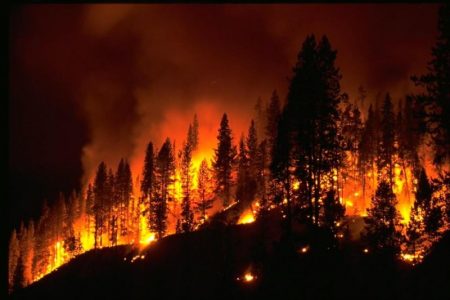August 11, 2018 – I have been extremely reluctant to implicate climate change alone as the cause of this summer of wildfires across the Northern Hemisphere, from Central Asia and Europe to Western North America. Many headlines, however, have appeared in the media attributing wildfires to anthropogenic climate change. Are they right?
Some would argue that the media and some scientists in the field have got it wrong. They propose that human factors not related to carbon release are a strong causal agent. And what are these factors?
- poor forest and land management policies
- and increased human encroachment on forest and wild areas.
In California and British Columbia, human settlements have crept into forested areas for decades. And where humans go fire follows. Our forestry and land management practices further exacerbate the conditions out of a conservationist concern not to deal with dead and fallen trees, leaving them in situ to become fire fodder. And then there is the human use of fire which often is to blame for starting wildfires.
The Union of Concerned Scientists, however, disagree with these explanations. Based on a study published in the journal Science in August of 2006 they reference data from the United States Department of Agriculture and the Forest Service which shows increased budgets and percentage of budgets being consumed to contain and put out wildfires.
The Forest Service, in a 2015 report, blamed climate change for the lengthening of the wildfire season in the Western United States stating that since 1970 the fire season has grown by 78 days. That same report noted that the size of wildfires have increased and projected that by mid-century the amount of forestland affected by fire will more than double.
One line in the Forest Service report stood out to me after all the talk about climate change. It pointed to “increasing development in fire-prone areas” as a significant change related to wildfire frequency and costs associated with fighting them.
There is no doubt that climate change is altering precipitation and temperatures across the planet. This summer is no exception. Over the last four years we have seen the four warmest on record since we began tracking temperatures globally. The latest projections place 2018 as the fourth hottest year only surpassed by the three previous ones.
At the same time climatologists have taken note of a shifting climate boundary that roughly ran along the 100th parallel of longitude since recordkeeping began. This line which roughly bisects the country from north to south has shifted by 2 degrees amounting to a drier America moving east by 225 kilometers (140 miles). To the east is wet America. To the west is a growing, drying area of the country. I wrote about this observation back on April 16, 2018 and highly recommend you read it to appreciate how anthropogenic-influenced climate change is having a real impact.
But there are climatologists who disagree with the Union of Concerned Scientists, not absolutely, but in terms of the degree climate change plays in wildfire activity. One of the dissenting voices is climate scientist, Cliff Mass, who teaches at the University of Washington. Mass has read the California data very differently seeing no appreciable increase in the number of wildfires over the last century in that state. He argues in a recently published blog that the wildfires are for the most not climate-change related but linked directly to other human behaviours: population encroaching on wild areas within the state, and our fascination with fire.
He accuses the press and members of the government in California of providing misinformation to the public and writes “there are so many factors that must be considered.”
Here is his list:
- fire is a fact borne out in the history of California based on its existing ecology ( in other words this is a natural fire-prone environment).
- increases in human population in the state has led to increased vulnerability to forests with humans responsible for starting most of the fires (the Forest Service attributes most fires being started by humans versus lightning strikes).
- climate change that is impacting precipitation patterns is influencing fire frequency and size (here he agrees with the Union of Concerned Scientists).
- mismanagement of forests and wild areas is creating ground conditions suitable for fires to break out (this is also in agreement with the Union of Concerned Scientists and many in forestry).
- human introduction of invasive species of plants, for example, cheatgrass and Eucalyptus, means more inflammable biomass can be found in California (this is human caused since we are the ones importing exotic, alien plant species from all around the world with unintended consequences).
A final comment about Mass’ conclusions. His remarks and observations are confined to California wildfire data and not incidents and frequency of wildfires elsewhere. It would be interesting to see if his conclusions hold water when data comparisons are made with British Columbia, Northern Ontario, Scandinavia, Siberia, Spain, Portugal, Greece, and other locales where this summer’s wildfires are burning fiercely.









